Joan Espasa
Behaviour Planning: A Toolkit for Diverse Planning
May 07, 2024Abstract:Diverse planning is the problem of generating plans with distinct characteristics. This is valuable for many real-world scenarios, including applications related to plan recognition and business process automation. In this work, we introduce \emph{Behaviour Planning}, a diverse planning toolkit that can characterise and generate diverse plans based on modular diversity models. We present a qualitative framework for describing diversity models, a planning approach for generating plans aligned with any given diversity model, and provide a practical implementation of an SMT-based behaviour planner. We showcase how the qualitative approach offered by Behaviour Planning allows it to overcome various challenges faced by previous approaches. Finally, the experimental evaluation shows the effectiveness of Behaviour Planning in generating diverse plans compared to state-of-the-art approaches.
On Grid Graph Reachability and Puzzle Games
Oct 02, 2023Abstract:Many puzzle video games, like Sokoban, involve moving some agent in a maze. The reachable locations are usually apparent for a human player, and the difficulty of the game is mainly related to performing actions on objects, such as pushing (reachable) boxes. For this reason, the difficulty of a particular level is often measured as the number of actions on objects, other than agent walking, needed to find a solution. In this paper we study CP and SAT approaches for solving these kind of problems. We review some reachability encodings and propose a new one. We empirically show that the new encoding is well-suited for solving puzzle problems in the planning as SAT paradigm, especially when considering the execution of several actions in parallel.
Challenges in Modelling and Solving Plotting with PDDL
Oct 02, 2023


Abstract:We study a planning problem based on Plotting, a tile-matching puzzle video game published by Taito in 1989. The objective of this game is to remove a target number of coloured blocks from a grid by sequentially shooting blocks into the grid. Plotting features complex transitions after every shot: various blocks are affected directly, while others can be indirectly affected by gravity. We highlight the challenges of modelling Plotting with PDDL and of solving it with a grounding-based state-of-the-art planner.
Towards a Model of Puzznic
Oct 02, 2023Abstract:We report on progress in modelling and solving Puzznic, a video game requiring the player to plan sequences of moves to clear a grid by matching blocks. We focus here on levels with no moving blocks. We compare a planning approach and three constraint programming approaches on a small set of benchmark instances. The planning approach is at present superior to the constraint programming approaches, but we outline proposals for improving the constraint models.
Towards Automatic Design of Factorio Blueprints
Oct 02, 2023Abstract:Factorio is a 2D construction and management simulation video game about building automated factories to produce items of increasing complexity. A core feature of the game is its blueprint system, which allows players to easily save and replicate parts of their designs. Blueprints can reproduce any layout of objects in the game, but are typically used to encapsulate a complex behaviour, such as the production of a non-basic object. Once created, these blueprints are then used as basic building blocks, allowing the player to create a layer of abstraction. The usage of blueprints not only eases the expansion of the factory but also allows the sharing of designs with the game's community. The layout in a blueprint can be optimised using various criteria, such as the total space used or the final production throughput. The design of an optimal blueprint is a hard combinatorial problem, interleaving elements of many well-studied problems such as bin-packing, routing or network design. This work presents a new challenging problem and explores the feasibility of a constraint model to optimise Factorio blueprints, balancing correctness, optimality, and performance.
Bridging the Gap between Structural and Semantic Similarity in Diverse Planning
Oct 02, 2023Abstract:Diverse planning is the problem of finding multiple plans for a given problem specification, which is at the core of many real-world applications. For example, diverse planning is a critical piece for the efficiency of plan recognition systems when dealing with noisy and missing observations. Providing diverse solutions can also benefit situations where constraints are too expensive or impossible to model. Current diverse planners operate by generating multiple plans and then applying a selection procedure to extract diverse solutions using a similarity metric. Generally, current similarity metrics only consider the structural properties of the given plans. We argue that this approach is a limitation that sometimes prevents such metrics from capturing why two plans differ. In this work, we propose two new domain-independent metrics which are able to capture relevant information on the difference between two given plans from a domain-dependent viewpoint. We showcase their utility in various situations where the currently used metrics fail to capture the similarity between plans, failing to capture some structural symmetries.
A Good Snowman is Hard to Plan
Oct 02, 2023Abstract:In this work we face a challenging puzzle video game: A Good Snowman is Hard to Build. The objective of the game is to build snowmen by moving and stacking snowballs on a discrete grid. For the sake of player engagement with the game, it is interesting to avoid that a player finds a much easier solution than the one the designer expected. Therefore, having tools that are able to certify the optimality of solutions is crucial. Although the game can be stated as a planning problem and can be naturally modelled in PDDL, we show that a direct translation to SAT clearly outperforms off-the-shelf state-of-the-art planners. As we show, this is mainly due to the fact that reachability properties can be easily modelled in SAT, allowing for shorter plans, whereas using axioms to express a reachability derived predicate in PDDL does not result in any significant reduction of solving time with the considered planners. We deal with a set of 51 levels, both original and crafted, solving 43 and with 8 challenging instances still remaining to be solved.
A Framework for Generating Informative Benchmark Instances
May 29, 2022
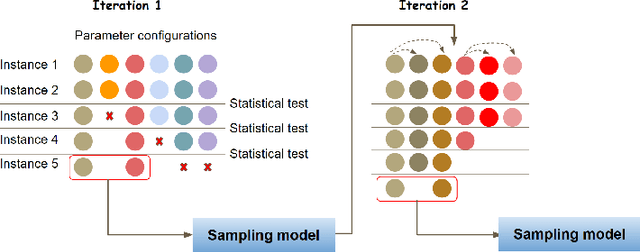
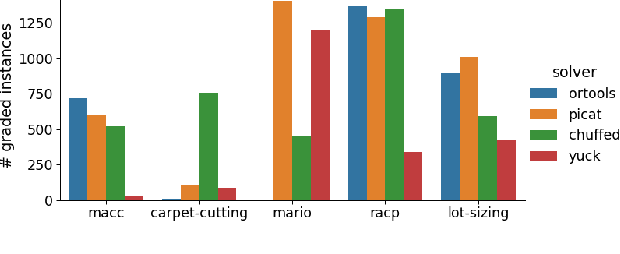

Abstract:Benchmarking is an important tool for assessing the relative performance of alternative solving approaches. However, the utility of benchmarking is limited by the quantity and quality of the available problem instances. Modern constraint programming languages typically allow the specification of a class-level model that is parameterised over instance data. This separation presents an opportunity for automated approaches to generate instance data that define instances that are graded (solvable at a certain difficulty level for a solver) or can discriminate between two solving approaches. In this paper, we introduce a framework that combines these two properties to generate a large number of benchmark instances, purposely generated for effective and informative benchmarking. We use five problems that were used in the MiniZinc competition to demonstrate the usage of our framework. In addition to producing a ranking among solvers, our framework gives a broader understanding of the behaviour of each solver for the whole instance space; for example by finding subsets of instances where the solver performance significantly varies from its average performance.
A Preliminary Case Study of Planning With Complex Transitions: Plotting
Oct 27, 2021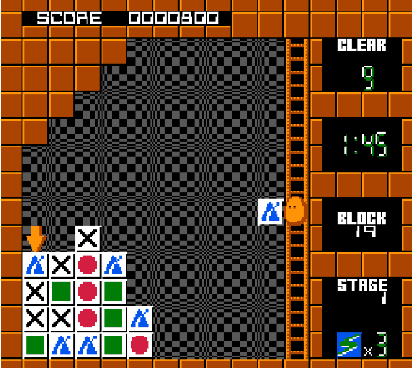

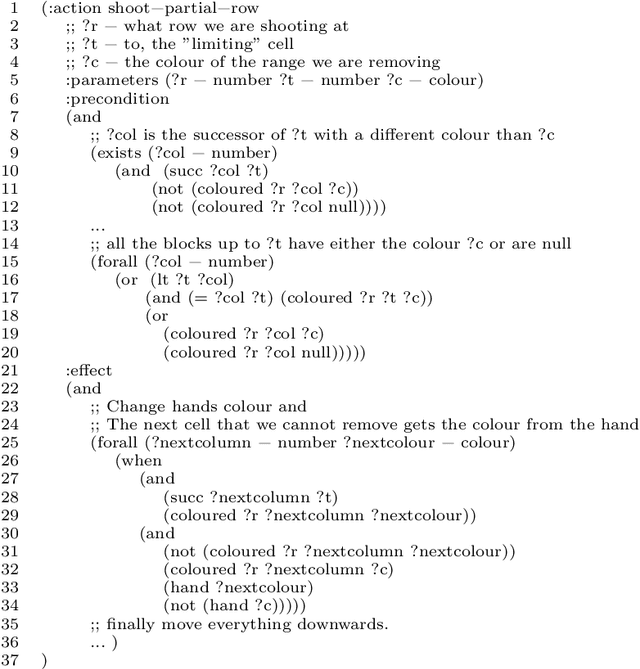
Abstract:Plotting is a tile-matching puzzle video game published by Taito in 1989. Its objective is to reduce a given grid of coloured blocks down to a goal number or fewer. This is achieved by the avatar character repeatedly shooting the block it holds into the grid. Plotting is an example of a planning problem: given a model of the environment, a planning problem asks us to find a sequence of actions that can lead from an initial state of the environment to a given goal state while respecting some constraints. The key difficulty in modelling Plotting is in capturing the way the puzzle state changes after each shot. A single shot can affect multiple tiles directly, and the grid is affected by gravity so numerous other tiles can be affected indirectly. We present and evaluate a constraint model of the Plotting problem that captures this complexity. We also discuss the difficulties and inefficiencies of modelling Plotting in PDDL, the standard language used for input to specialised AI planners. We conclude by arguing that AI planning could benefit from a richer modelling language.
Using Small MUSes to Explain How to Solve Pen and Paper Puzzles
Apr 30, 2021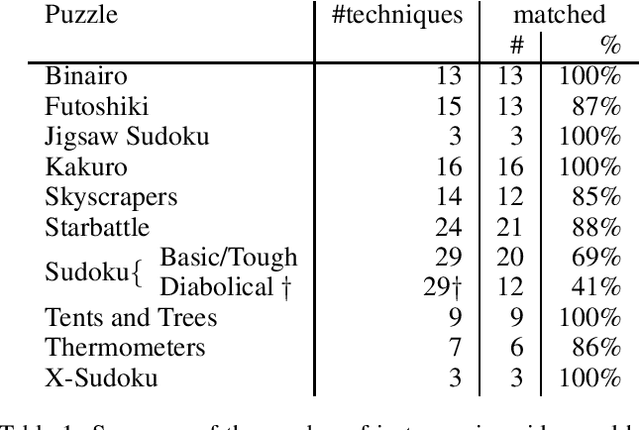
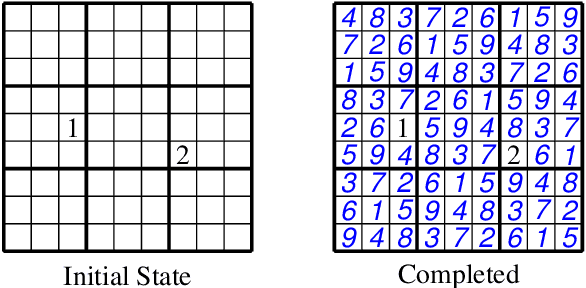
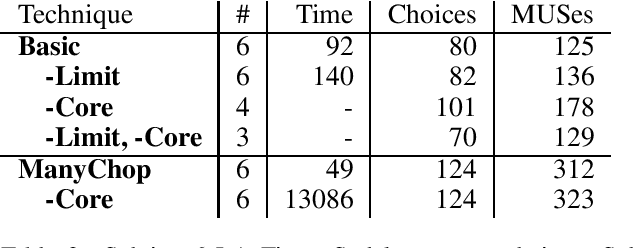
Abstract:Pen and paper puzzles like Sudoku, Futoshiki and Skyscrapers are hugely popular. Solving such puzzles can be a trivial task for modern AI systems. However, most AI systems solve problems using a form of backtracking, while people try to avoid backtracking as much as possible. This means that existing AI systems do not output explanations about their reasoning that are meaningful to people. We present Demystify, a tool which allows puzzles to be expressed in a high-level constraint programming language and uses MUSes to allow us to produce descriptions of steps in the puzzle solving. We give several improvements to the existing techniques for solving puzzles with MUSes, which allow us to solve a range of significantly more complex puzzles and give higher quality explanations. We demonstrate the effectiveness and generality of Demystify by comparing its results to documented strategies for solving a range of pen and paper puzzles by hand, showing that our technique can find many of the same explanations.
 Add to Chrome
Add to Chrome Add to Firefox
Add to Firefox Add to Edge
Add to Edge